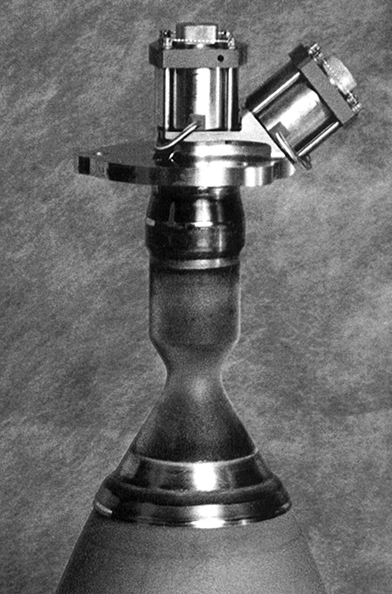Giving Bigger Satellites a Boost
With the increased complexity of communications here on Earth, satellite makers are becoming compelled to send heavier equipment into orbit. Just as sport utility vehicle owners begrudge the amount it costs to fill up the tank on their gas guzzlers, satellite makers are eager to find ways of making more efficient thrusters for their weightier satellites. With this in mind, NASA, private industry, and other government agencies have been pooling their resources to help Ultramet, Inc., of Pacoima, California, make blasting satellites into orbit a more efficient and inexpensive process. Small Business Innovation Research (SBIR) funding from NASA's Glenn Research Center has spurred a new process for producing rocket engine thrust chambers.
Liquid rocket engine performance has historically been constrained by the limitations of materials and processes used for component fabrication. Typically, the thrust chamber, in which the propellants are combusted, must be cooled to avoid the breakdown of materials, causing possible failure during operation. Cooling can effectively be achieved by various means that, unfortunately, result in a loss of efficiency.
Rocket engine efficiency is generally defined by a measurement that indicates pounds of thrust per second of consumed fuel. This measurement is called specific impulse, or Isp, which is more or less analogous to miles per gallon. Higher values of Isp indicate higher operating efficiency. Considering the high costs of sending a single pound payload to orbit, the value of a modest gain in Isp is important. Such a gain in efficiency requires high temperatures--over 2,000 degrees Celsius! These temperatures, however, also bring the possibility of materials breakdown. Therefore, engineers do not want increases in operating temperatures at the expense of engine reliability.
The key to achieving high-temperature capability without compromising reliability was developed, in part, because of NASA SBIR funding. High-temperature oxidation-resistant thruster materials are being fabricated by Ultramet with a novel process, which has been proven effective during successful flights of the latest generation satellites.
The approach used for the development of such high-performance materials is simple in concept, but innovative in its execution. Using a process called chemical vapor deposition (CVD), Ultramet is producing high-temperature capability thrust chambers. CVD involves heating precursors for metals, such as iridium and rhenium, to temperatures at which they become gaseous and depositing them onto a mandrel, or spindle, layer-by-layer to produce high-density, highly resistant materials from the inside out.
In addition to NASA, several large companies have invested nearly $25 million in the development of this technology. The payoff for the satellite industry will prove to be quite large. Ultramet estimates that a three-percent improvement in propulsion system performance of a satellite could be gained. That can be equated to a 50- to 100-kilogram increase in the weight of communications mass on a satellite, a significant increase in satellite thrust capability. This gives the ever-advancing communications industry some room to broaden its capabilities.

Ultramet, Inc., is manufacturing high-temperature oxidation-resistant thruster materials.













